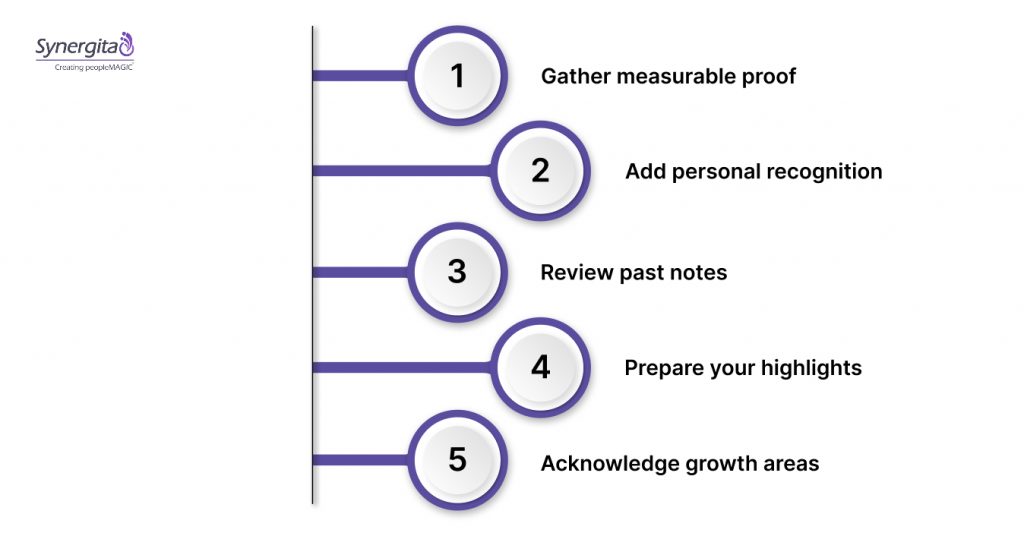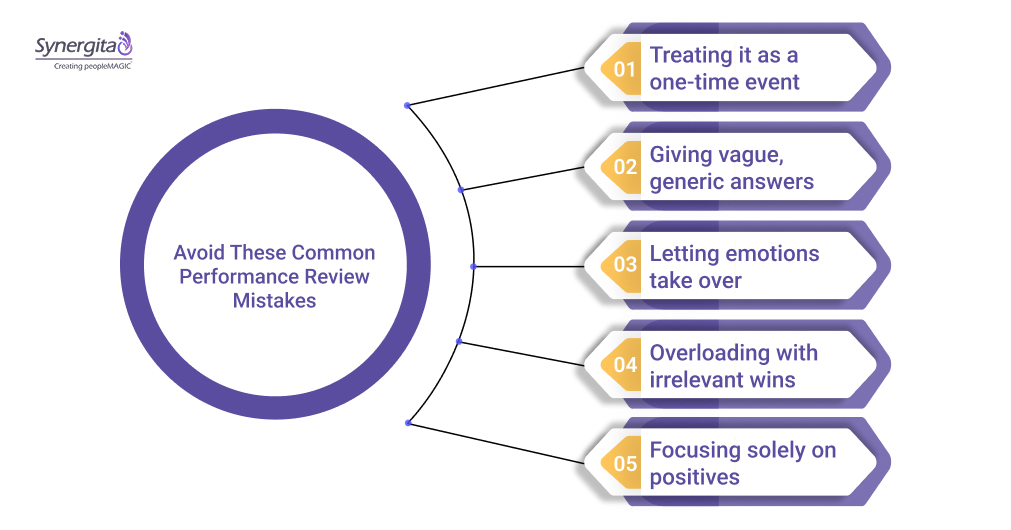What if your performance review wasn’t just about ticking boxes but a real chance to grow and succeed? With the right approach, it can be exactly that. Knowing how to handle performance review effectively turns it from a stressful meeting into a meaningful conversation that clarifies expectations, celebrates your wins, and sets you up for what’s next.
Come in with solid examples of your impact, be open to feedback, and keep your focus on shared goals, and you’ll turn each review into a dialogue that fuels both your career growth and your team’s success. In this blog, we’ll share practical, actionable tips on how to handle performance reviews with confidence so you can walk away feeling motivated and ready for the future.
Key Takeaways
- Prepare like a pro – gather relevant metrics, success stories, and past feedback so you can speak confidently about your progress.
- Make it a real conversation – actively listen, share your perspective clearly, and work with your manager to find solutions together.
- Handle feedback with curiosity – ask for examples, clarify expectations, and outline the steps you’ll take to improve.
- Highlight your achievements – showcase your most impactful results with complex data and recognition from peers or clients.
- Set future goals with clarity – agree on specific, measurable objectives that align with team and organizational priorities.
- Keep the process continuous – with Synergita, transform performance reviews into ongoing, transparent, and growth‑driven conversations.
Preparation Before the Performance Review

Walking into a review unprepared can leave you reacting instead of leading the conversation. Planning can help you present your achievements with clarity and confidence.
- Gather measurable proof – Numbers speak clearly. Bring metrics like sales growth, projects completed, or customer satisfaction scores to show your results in action.
- Add personal recognition – Back up the data with human stories like peer shout‑outs, manager compliments, or client testimonials that highlight your soft skills and influence.
- Review past notes – Look over previous feedback to spot trends: where you’ve improved, and where progress is still needed.
- Prepare your highlights – Choose 2–3 key wins and be ready to explain their business impact.
- Acknowledge growth areas – Show self-awareness by naming one or two areas for improvement and having ideas for how to address them.
Effective Communication During the Review
A performance review works best when it’s a genuine two-way conversation. The goal is to listen, share openly, and leave with clear next steps. Here’s how to make that happen:
- Listen fully before responding – Give your manager your full attention and keep an open mind to understand their perspective.
- Share your thoughts clearly – Use simple, direct language, and avoid slipping into jargon or defensive responses.
- Handle tough feedback with curiosity – Instead of reacting emotionally, ask: “Can you give me a specific example?” or “What’s one way I could improve?”
- Acknowledge growth areas – Accept improvement points openly, and outline how you plan to address them.
- Show commitment through action – End the discussion by confirming next steps and your dedication to putting feedback into practice.
Why this works: Clear, respectful communication builds trust, turns feedback into actionable steps, and transforms the review into a shared plan for success.
Responding to Feedback
We’ve all had those moments in a review when feedback catches us by surprise. What really matters is how you respond in that moment, as it can transform pressure into progress.
- Have you ever received feedback that caught you off guard? Pause before responding to give yourself time to think rather than react emotionally.
- Unsure about what your manager means? Ask for specific examples — “I want to be sure I understand; could you walk me through a recent instance?”
- Does the feedback feel challenging or unfair? Seek context first before forming conclusions, so your response is based on facts.
- Ready to show commitment? Outline how you’ll put the feedback into action to drive improvement and results.
Why this works: Turning feedback into a dialog rather than a defense builds trust, strengthens relationships, and keeps the focus on actionable growth.
Highlighting Achievements and Contributions
Improvement matters, but so does celebrating what you’ve accomplished. Share your recent wins with confidence.
Use specific examples:
- A skill you’ve mastered or significantly improved.
- A project you drove to completion with successful results.
- A contribution that delivered measurable impact.
Balancing constructive feedback with clear achievements gives a well‑rounded picture of your performance.
And don’t just mention your wins — prove them. Please support them with facts, such as metrics, reports, or recognition from peers and managers. This not only highlights your value but also makes your contributions stand out.
Setting Future Goals and Expectations
A performance review isn’t just about what’s happened so far — it’s your chance to talk about where you’re headed.
Think of it as a friendly chat about your future at the company.
- Get clear on what’s expected from you in the coming months so there are no surprises.
- Share your ideas for making things better — whether it’s a new process, a project improvement, or a minor tweak that could help the team.
- Show you’re eager to grow by offering to take on bigger challenges or learn new skills.
- Agree on specific goals so you and your manager both know what success will look like next time.
By keeping it open, positive, and forward-looking, your review can become less of a “check-up” and more of a growth plan.
Post-Review Actions
Once the review is complete, document the agreed-upon goals and expectations for reference. This formalization helps in tracking progress and maintaining accountability.
Schedule regular check-ins with your manager to monitor your performance and adjust plans as needed. Consider follow-up meetings to revisit feedback and achievements, ensuring continuous alignment.
Reflect on the feedback received and actively integrate it into your daily work practices to drive ongoing improvement.
Continuous Performance Management
Performance reviews don’t need to be once-a-year, high-pressure events. Turn them into regular check‑ins that keep you growing, motivated, and aligned with team goals.
Here’s the exciting part: companies with continuous, people‑first performance management are over 4× more likely to outperform competitors, see 30% higher revenue growth, and have lower turnover. Ongoing feedback helps you — and the business — succeed.
- Keep preparing often. When you reflect regularly, you stay ahead and avoid surprises at review time.
- Meet up frequently. Think of brief monthly or quarterly chats that make feedback feel like a helpful part of your journey—not just a report card.
- Connect your goals. Make sure your work matters by linking your achievements to your team’s and the company’s bigger objectives.
Avoid These Common Performance Review Mistakes

Performance reviews can shape your growth — but only if you steer clear of these pitfalls:
- Treating it as a one‑time event – Don’t wait until review day to raise challenges or showcase achievements. Stay engaged year‑round so you can course‑correct early.
- Giving vague, generic answers – Respond to feedback with clear, specific examples instead of surface‑level statements.
- Letting emotions take over – Stay composed and solution‑focused, even when feedback surprises or challenges you.
- Overloading with irrelevant wins – Share only the achievements that matter to your role and goals.
- Focusing solely on positives – Acknowledge areas to improve; avoiding them can make you appear unbalanced or unaware.
Avoiding these mistakes is just one side of the coin — the other is making feedback a continuous, helpful part of your work life.
Alternative Ways to Collect Feedback
Regular feedback is essential to keep your growth on track — waiting too long between reviews can slow progress.
Keep the conversation going so you and your manager stay on the same page.
You could:
- Have informal catch‑ups over coffee or during team huddles.
- Ask for 360‑degree feedback from peers to see how others experience working with you.
- Use quick pulse surveys to get real‑time insights into your performance.
The benefit? You spot blind spots early and can make changes right away. When feedback is regular and specific, performance reviews feel less stressful — and you stay engaged and growing all year round.
Synergita Supports Effective Performance Reviews
Handling a performance review effectively means knowing how to handle a performance review in a way that makes it continuous, transparent, and growth‑focused — not just a yearly event. Regular preparation, frequent feedback, aligned goals, and avoiding common mistakes lead to more purposeful discussions.
Consistent check‑ins, open dialogue, and clear expectations reduce stress and strengthen manager–employee relationships, turning reviews into strategic opportunities for success.
With Synergita, reviews shift into a continuous, results‑driven process. Real‑time dashboards, ongoing feedback, SMART goal tracking, and analytics keep progress clear, goals aligned, and conversations impactful.
The result? Clear direction, stronger collaboration, and measurable growth. With Synergita, every review becomes an opportunity to excel. Start your free trial today. Or check out our other resources for strategies that help winning teams stay on top.
FAQs
1. What should I do if I receive unexpected or critical feedback during my review?
Pause before responding, seek specific examples for clarity, avoid reacting emotionally, and emphasize your commitment to improving and taking actionable steps.
2. How do I set goals during a performance review?
Agree on clear, measurable, and attainable goals that align with your team and company’s priorities, making sure you both understand expectations for future success.
3. How can I handle a review if I disagree with the feedback given?
Ask for concrete examples and context to better understand the feedback, stay respectful and solution-focused, and work with your manager to identify steps for improvement.
4. How can I handle emotional responses during a review?
Pause, breathe, and listen fully before responding. Treat feedback as a chance to learn rather than a personal attack, and keep the focus on solutions.


